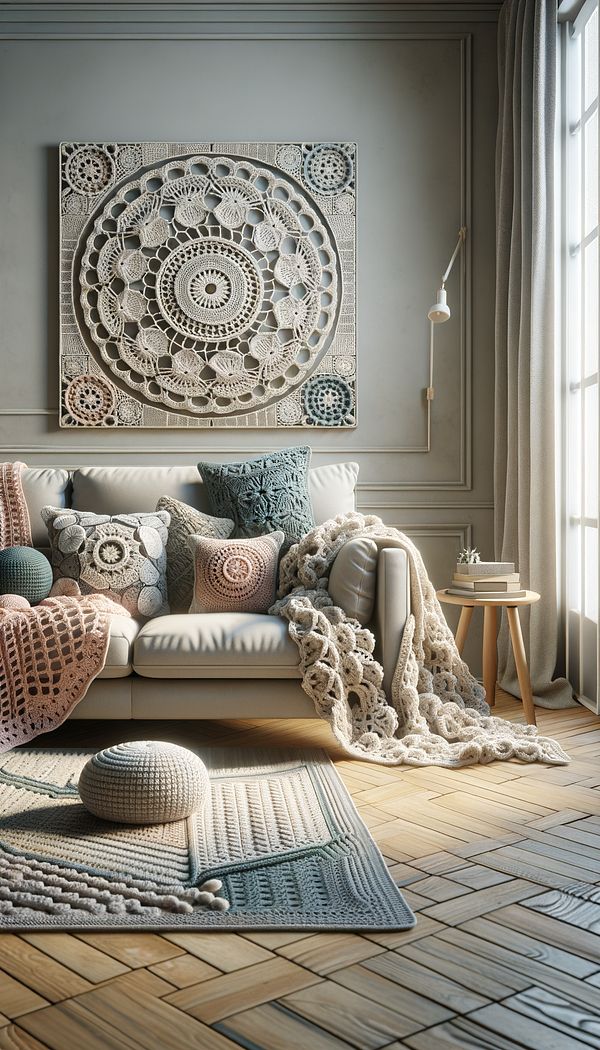What is Crocheting?
Crocheting is a versatile textile art form involving the interlocking of loops of yarn, thread, or other materials using a crochet hook.
Description
Crocheting, a creative and versatile textile art form, has found its place in the domain of interior design, offering endless possibilities for creative expression and customization. Utilizing a single crochet hook, practitioners interlock loops of yarn, thread, or even other innovative materials, to craft items both decorative and functional. Unlike knitting, which uses two needles, crocheting relies on one hook, making it uniquely adept at creating intricate patterns and textures with relative ease.
Incorporated seamlessly into various design styles, crocheted items add a touch of warmth and homeliness to any space. From contemporary to bohemian, crocheted accents can complement any aesthetic, promoting a cohesive and inviting atmosphere. The ability to customize color, texture, and pattern enables crocheting to adapt fluidly to the evolving tastes and trends within interior design. Moreover, its environmentally friendly potential—especially when upcycling materials—is a boon for those embracing sustainability in their design choices.
A tangible connection to traditional craftsmanship, crocheting also invites a personal touch into interior spaces. Handmade items carry with them stories and histories, imbuing rooms with a sense of identity and character. This craft offers a soothing, meditative activity for the creator, while endowing the recipient with a unique, bespoke element that reflects careful thought and affection.
Usage
Crocheting is commonly employed in interior design through items such as throw blankets, cushion covers, poufs, wall hangings, and even intricate lampshades. Its adaptability to various textures and materials also allows for the creation of unique rugs and decorative objects, incorporating crocheted elements into a room’s overall design theme. Home accessories and accents become conversation pieces, reflecting the craftsmanship and creativity infused into each crocheted item.
FAQs
-
What materials can be used for crocheting?
Besides the traditional yarn and thread, crocheting can incorporate a wide range of materials, including recycled textiles, natural fibers like bamboo and cotton, and unconventional items like twine or wire, broadening its application in creative and sustainable design.
-
Is crocheting only suitable for traditional or vintage interior styles?
Absolutely not. While crocheting does have historical roots, its versatility allows it to blend seamlessly into a variety of design aesthetics, from modern and minimalistic to eclectic and bohemian. The key lies in the choice of materials, colors, and patterns
-
Can crocheting be considered a sustainable design choice?
Yes, especially when using upcycled or natural materials. Crocheting offers a unique opportunity to contribute to sustainable and eco-friendly design practices by minimizing waste and promoting the repurposing of second-hand textiles.
Practical Application
To incorporate crocheting into your interior design, start with small, accent pieces to understand how the texture and pattern work within your space. Experiment with color schemes and yarn materials to find the perfect fit for your design aesthetic. For a truly unique touch, consider custom crocheted items that reflect personal interests or tell a story, adding both warmth and character to your environment.
-
Decorative Techniques322 articles
-
Fabrication & Craftsmanship133 articles
-
Materials & Textiles360 articles
-
Textiles & Upholstery252 articles
-
Sustainability & Eco-Friendly Design69 articles
-
Arts & CraftsArts & Crafts refers to both an interior design style and a movement prioritizing handcrafted, simple forms often inspired by nature.
-
ChambrayChambray is a lightweight cotton fabric with a plain weave and a slightly glossy surface.
-
Italian RenaissanceItalian Renaissance refers to the revival of classical art and architecture originating in Italy in the 14th century.
-
FoundationFoundation refers to the lowest load-bearing part of a building which is typically situated below ground level.
-
HeadingHeading refers to the top section of a curtain or drapery that attaches to the track or rod.
